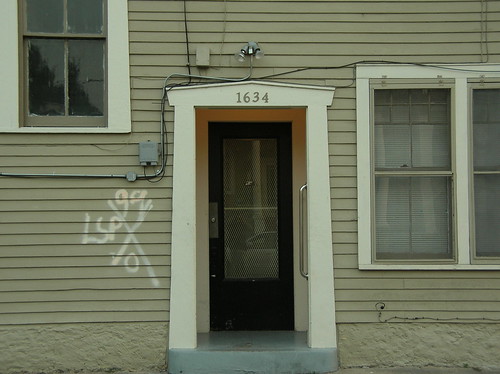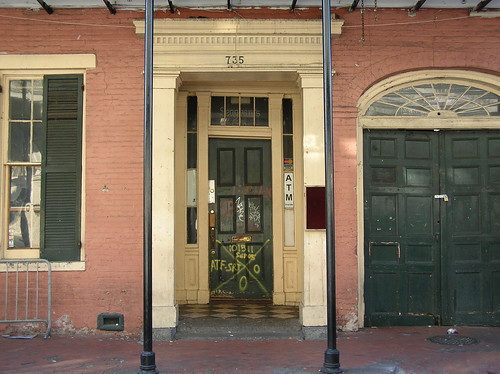
That picture is one of the famous "X" marks left over by search and rescue teams moving through New Orleans after the Federal Flood. If you need a refresher on what the codes indicate you can look here. This mark tells us that when the team came by this address on.. I think that says September 9, they found no hazards of note (right quadrant) and, more importantly zero bodies (bottom quadrant.)
That shouldn't be too surprising given that this house is near St. Charles Avenue; Uptown and close enough to the river to escape the flooding. (Here is a T-P animated graphic that shows where the water came from and where it went. Useful for explaining things to the unfamiliar this weekend.)
What may surprise some to learn, though, is that I took that photograph just this past Thursday. It turns out a lot of people, in the course of rebuilding their homes and lives, decided to keep the marks.
The T-P asked some of them to talk about it. This was my favorite response.
Augusta and Robert Elmwood, St. RochLooking back through my old pictures, I'm a little surprised I didn't photograph more of these while they were still fresh. I can only find a couple. This was also Uptown taken in June 2006.
"There are several reasons we choose to leave the well-known Katrina X on our house. The public reason: as a sort of reminder, 'Lest we forget...' Another Katrina may be just around the corner. Also on a grander scale, it should be a reminder to all, that man and all his things are vulnerable in the face of raw nature, and that our lives are fragile and can be changed or taken from us in an instant. Our private reasons: It is our badge of honor. We paid our dues and stuck it out for 10 days before we had to leave because my husband was running out of his medications. He calls it our 'combat medal.' It is also a reminder of the misery we shared with so many others who stayed behind, our eternal bond with them and the city. It is a reminder of the event that affected so many lives. We and our children will always preface stories and recall events with the phrase, 'Before Katrina....' I also want it to remain in memory of those long-gone ancestors who perished in unnamed hurricanes since the earliest days of this city. Our X was made on Sept. 11 (9-11) by a unit from Texas (TXO). They did not enter the house (NE), and we are fortunate that the lower quadrant is empty. And that is why we would never paint over or conceal it. In fact, we are considering having a metal image of it made and attached to the house, directly over it, so that the actual mark appears to be a shadow. Then, even if the paint peels off, the reminder will endure."

This is 735 Bourbon Street in March 2006

Katrina and the flood have formed an indelible mark on our lives. It is the palimpsest upon which every story about our city today is written. Nine years later, it is impossible to understand anything happening in New Orleans without talking about how that thing was made possible or necessary by Katrina.
A few weeks ago I read this article titled, "How to Tell When New Orleans Has Recovered From Katrina."
Allison Plyer, head of The Data Center in New Orleans, sees the overall recovery as basically on track – 90 out of a possible 100 – but she also sees clear evidence of what some call the two faces of Katrina. On one hand, some people in New Orleans are experiencing a “greater than 100 percent” recovery, says Plyer, because the city has better facilities, improved flood protection and a growing economy (rather than the shrinking economy it had pre-Katrina). But, says Plyer, “others feel like they haven’t recovered at all or that they are even worse off than they were before Katrina.”
Flozell Daniels, Jr., works with underserved communities as head of the Foundation for Louisiana and sees that recovery gap first-hand. So he gives the overall recovery a lower mark – “I’d say we’re about 50 percent there” – and believes that the true timeline for recovery is likely a generation.
The answer, if you read between the lines of that is, we never "recover." We just continue along an altered path. We continue for as long as we can, anyway. Which, of course, might not be for too much longer given the engineering of challenges of just keeping the city habitable.. or even on the map.
A few nights ago I was messing around on YouTube when I came across this circa 2006 BBC documentary. It's a little hokey in spots. It asks, "Should the city be rebuilt?" which is pretty insulting. But it also covers the disaster and its causes very well. Watching this really brought back the uncertainty of the time.
Because politicians, tourism promoters, and real estate agents, like to tell happy stories, the story you're more likely to read these days tells you the worst is now behind us. This is, in all likelihood, the exact opposite of true.
Here is a slick report produced report by The Lens and Pro Publica graphically detailing the extent to which Louisiana's coastline has eroded during most of our lifetimes.. and the probability that it will be gone before many of our lifetimes have ended.
I don't like that "largely unnoticed" bit. I'm an old dude now and I can speak with some authority when I say that this has been a known and widely discussed issue for at least the three decades that I can remember having heard it discussed. It's been noticed.In just 80 years, some 2,000 square miles of its coastal landscape have turned to open water, wiping places off maps, bringing the Gulf of Mexico to the back door of New Orleans and posing a lethal threat to an energy and shipping corridor vital to the nation’s economy.And it’s going to get worse, even quicker.
Scientists now say one of the greatest environmental and economic disasters in the nation’s history is rushing toward a catastrophic conclusion over the next 50 years, so far unabated and largely unnoticed.
Getting people to notice is different from getting them to do anything about, though. The report goes into that too. But if you're reading this, you probably already know that story as well. The state has a $50 billion master plan for rebuilding the coast. If fully implemented, the plan will still result in a huge annual net loss of land until the year 2060 at the earliest.
The plan is unlikely to be fully implemented, however, because the last year has demonstrated the lengths to which the state's political class will go to protect the oil and gas industry from being held liable. Instead, our representatives say they are working out a less punitive (and less lucrative) settlement. And in the process, they've introduced an interesting new concept.
Coastal Louisiana's future comes in various sizes now. It's like choosing a health plan. If you are at greater risk for catastrophe, you're going to want more robust protection... which is then likely to be out of your price range. If you're a South Louisiana resident, at least you have the benefit of a simple method to assess which plan might be in your best interest. Just check around your neighborhood to see how many X marks are still showing.
Kyle Graham, executive director of the Louisiana Coastal Protection and Restoration Authority, said recently that the industry understands its liability for the crumbling coast and is discussing some kind of settlement. “It's very difficult to see a future in which that [such an agreement] isn't there,” he said he said.
Graham has said current funding sources could keep the restoration plan on schedule only through 2019. He was blunt when talking about what would happen if more money doesn’t come through: There will be a smaller coast.
“There are various sizes of a sustainable coastal Louisiana,” he said. “And that could depend on how much our people are willing to put up for that.”
No comments:
Post a Comment